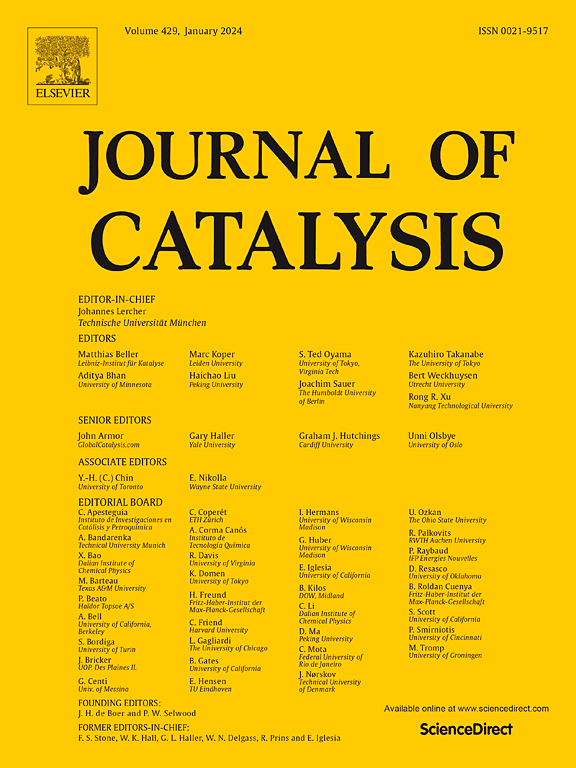Organic–inorganic hybridization boosts the catalytic performance of Mn-based catalysts in the aerobic oxidation of benzylic and allylic C–H bonds
IF 6.5
1区 化学
Q2 CHEMISTRY, PHYSICAL
引用次数: 0
Abstract
An unprecedented organic–inorganic hybrid material (BA-Ni2Mg2Mn) has been contrived using Ni2Mg2Mn layered double hydroxide (LDH) and benzoic acid as the precursors. The hybrid exhibited significantly higher catalytic activity than the precursor in the C(sp3)–H bonds oxidation via switching the reaction path of HAT (hydrogen atom transfer) for the Ni2Mg2Mn-LDH to PCET (proton-coupled electron transfer) process. The turnover frequency (TOF) value significantly boosted from 27 h−1 for Ni2Mg2Mn-LDH to 882 h−1 for the hybrid material in the aerobic oxidation of benzyl methyl ether, which exceeds most reported catalysts. The characterization suggested that metal cations in hybrid coordinated with carboxylic acid in a monodentate manner, which would elevate the positive charge of Mn3+ species and the surface basicity probably related to M–O2– structure. These improved properties facilitated the electron transfer and the proton transfer during the PCET process, respectively, and were responsible for the boosting catalytic performance for the hybrid in the aerobic oxidation of C(sp3)–H bonds. Various substrates can be tolerated by the present catalytic system, allowing the efficient synthesis of some valuable molecules over an extremely convenient reaction system employing molecular oxygen as the sole oxidant.


有机-无机杂化提高了锰基催化剂对苯基和烯丙基C-H键有氧氧化的催化性能
以Ni2Mg2Mn层状双氢氧化物(LDH)和苯甲酸为前驱体,制备了一种前所未有的有机无机杂化材料BA-Ni2Mg2Mn。通过改变Ni2Mg2Mn-LDH到PCET(质子耦合电子转移)的HAT(氢原子转移)反应路径,该杂化物在C(sp3) -H键氧化过程中表现出明显高于前驱体的催化活性。在苯甲醚的好氧反应中,Ni2Mg2Mn-LDH的周转频率(TOF)值从27 h−1显著提高到882 h−1,超过了大多数报道的催化剂。表征结果表明,杂化物中的金属阳离子与羧酸呈单齿配位,使Mn3+的正电荷升高,表面碱度可能与M-O2 -结构有关。这些改进的性质分别促进了PCET过程中的电子转移和质子转移,并提高了杂化物在C(sp3) -H键有氧氧化中的催化性能。目前的催化体系可以耐受各种底物,允许在使用分子氧作为唯一氧化剂的极其方便的反应体系上有效地合成一些有价值的分子。
本文章由计算机程序翻译,如有差异,请以英文原文为准。
求助全文
约1分钟内获得全文
求助全文
来源期刊

Journal of Catalysis
工程技术-工程:化工
CiteScore
12.30
自引率
5.50%
发文量
447
审稿时长
31 days
期刊介绍:
The Journal of Catalysis publishes scholarly articles on both heterogeneous and homogeneous catalysis, covering a wide range of chemical transformations. These include various types of catalysis, such as those mediated by photons, plasmons, and electrons. The focus of the studies is to understand the relationship between catalytic function and the underlying chemical properties of surfaces and metal complexes.
The articles in the journal offer innovative concepts and explore the synthesis and kinetics of inorganic solids and homogeneous complexes. Furthermore, they discuss spectroscopic techniques for characterizing catalysts, investigate the interaction of probes and reacting species with catalysts, and employ theoretical methods.
The research presented in the journal should have direct relevance to the field of catalytic processes, addressing either fundamental aspects or applications of catalysis.
 求助内容:
求助内容: 应助结果提醒方式:
应助结果提醒方式:


